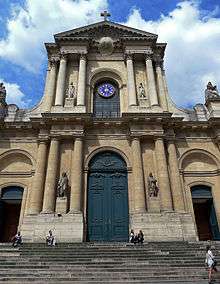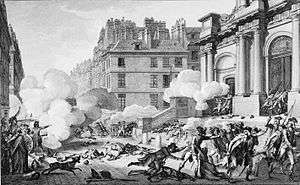Saint-Roch, Paris
| Saint-Roch, Paris | |
|---|---|
 Saint-Roch | |
| Basic information | |
| Location | 284 Rue Saint-Honoré, 1e |
| Geographic coordinates | 48°51′55″N 2°19′57″E / 48.86528°N 2.33250°ECoordinates: 48°51′55″N 2°19′57″E / 48.86528°N 2.33250°E |
| Affiliation | Catholic Church |
| Rite | Roman Rite |
| State | France |
| Province | Archdiocese of Paris |
| Region | Île-de-France |
| Status | Active |
| Heritage designation | 1862 |
| Website |
www |
| Architectural description | |
| Architectural type | Parish church |
| Architectural style | Baroque |
| Groundbreaking | 1653 |
| Completed | 1722 |
| Direction of façade | South |
| Official name: Eglise Saint-Roch | |
| Designated | 1914 |
| Reference no. | PA00085798[1] |
| Denomination | Église |
The Church of Saint-Roch (French: Église Saint-Roch) is a late Baroque church in Paris, dedicated to Saint Roch. Located at 284 rue Saint-Honoré, in the 1st arrondissement, it was built between 1653 and 1740.[2] The church is organized as a series of chapels. One of them is dedicated to Saint Susanna in memory of the church which used to stand in its place. Accordingly, there is a mural painting above the altar, showing Saint Susanna fleeing her attackers, and looking up to the heavens for the help of God. The Marquis de Sade was married in this church on May 17, 1763.
History
In 1521, the tradesman Jean Dinocheau had a chapel built on the outskirts of Paris, which he dedicated to Saint Susanna. In 1577, his nephew Etienne Dinocheau had it extended into a larger church. In 1629, it became the parish church and thereafter underwent further work. The first stone of the church of Saint-Roch was laid by Louis XIV in 1653, accompanied by his mother Anne of Austria. Originally designed by Jacques Lemercier, the building's construction was halted in 1660 and was resumed in 1701 under the direction of architect Jacques Hardouin-Mansart, brother of the better-known Jules Hardouin-Mansart. Work was finally completed in 1754.
At the time of the French Revolution, the church of Saint-Roch was often at the centre of events and was the scene of many shootings which have left their mark on the façade. 13 Vendémiaire was one such occasion, this was pivotal in the rise of Napoleon. It was not only the outside of the church that was damaged. During the Revolution it was ransacked, and many works of art were stolen or destroyed. Amongst the missing paintings was one of Dinocheau, a generous donor, who built the first church on this spot. His portrait, which used to hang in a side chapel, has been found and is now in Italy, in the church of Santa Maria Maggiore in Piedmont. This portrait is currently misidentified as that of Paul Feminis.
According to Tad Szulc, Chopin composed a Veni Creator prayer that he played on the organ during Mass at St. Roch, the 'Polish Church' [for the Poles living in exile in Paris]. [3]
Notable tombs
Notable tombs in the church include those of Denis Diderot, the Comte de Grasse, the Baron d'Holbach, Henri de Lorraine-Harcourt, Pierre Corneille, André le Nôtre, Marie Anne de Bourbon (daughter of Louis XIV) and Marie-Thérèse Rodet Geoffrin.
Gallery
- Chapel of St. Susanna, built in 1710.
 The Journée of 13 Vendémiaire, Year 4: Church of Saint-Roch, Rue Saint-Honoré, Paris.
The Journée of 13 Vendémiaire, Year 4: Church of Saint-Roch, Rue Saint-Honoré, Paris.
Location
| Located near the Métro station: Pyramides. |
References
- ↑ Mérimée database 1993
- ↑ Blackmore, Ruth (2012). The Rough Guide to Paris. London: Rough Guides. p. 71. ISBN 1405386959.
- ↑ Szulz, Tad (1998) Chopin in Paris, p332
External links
| Wikimedia Commons has media related to Église Saint-Roch de Paris. |
- Website (French)
- Structurae
- Description of the church (French)